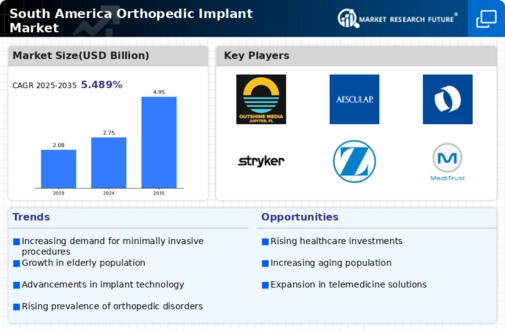The South America Orthopedic Implant Market is witnessing significant growth as healthcare infrastructure in the region improves and the demand for advanced medical treatments rises. This sector comprises a variety of products, including joint replacement implants, spinal implants, trauma devices, and orthobiologics. The competitive landscape is characterized by both global players and regional manufacturers, each with unique offerings and strategies to capture market share. The market dynamics are influenced by factors such as technological advancements, the aging population, increasing incidences of orthopedic disorders, and rising healthcare expenditure.
Competitive strategies such as mergers and acquisitions, partnerships, and innovative product development have made the South American orthopedic implant market a vibrant and evolving space where companies strive to establish a strong foothold.Johnson and Johnson has a notable presence in the South America Orthopedic Implant Market, showcasing a robust portfolio that emphasizes advanced surgical technologies and innovative implant solutions. The company's strengths lie in its extensive research and development capabilities, which enable continuous innovation based on the evolving needs of healthcare professionals and patients alike.
By focusing on quality and reliability, Johnson and Johnson has built a reputation for durability in its orthopedic products. Additionally, the company's ability to invest in strong distribution networks ensures that its implants are widely accessible in various regions across South America, further augmenting its market position. Johnson and Johnson takes an active approach in engaging with local healthcare systems and stakeholders, enhancing its overall brand visibility and trust among consumers.Aesculap is another key player in the South America Orthopedic Implant Market, known for its specialization in surgical instruments and implant solutions geared primarily toward orthopedic and trauma surgery.
The company offers a comprehensive range of products, including hip and knee implants, spinal systems, and surgical instruments. Aesculap positions itself strategically with local partnerships and collaborations, enabling it to respond effectively to market demands. One of the company's strengths includes its commitment to quality, which is reflected in its unique manufacturing processes and attention to detail. Furthermore, Aesculap has made significant strides through mergers and acquisitions that allow for an expanded portfolio and better market integration within South America.
The company continues to focus on delivering leading-edge technologies, which positions it well to meet the needs of modern surgical practices and contribute to better patient outcomes in the region.




















Leave a Comment